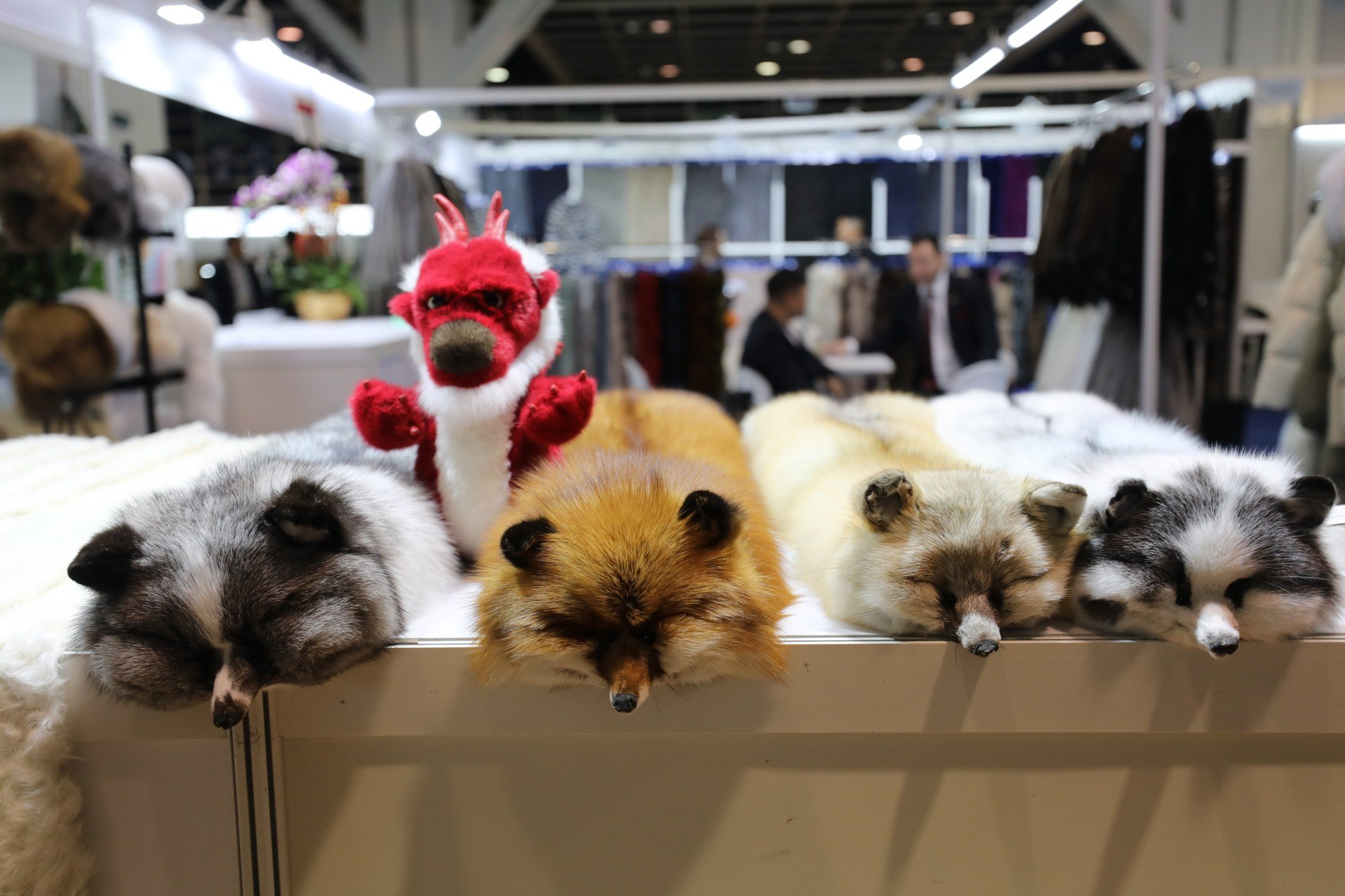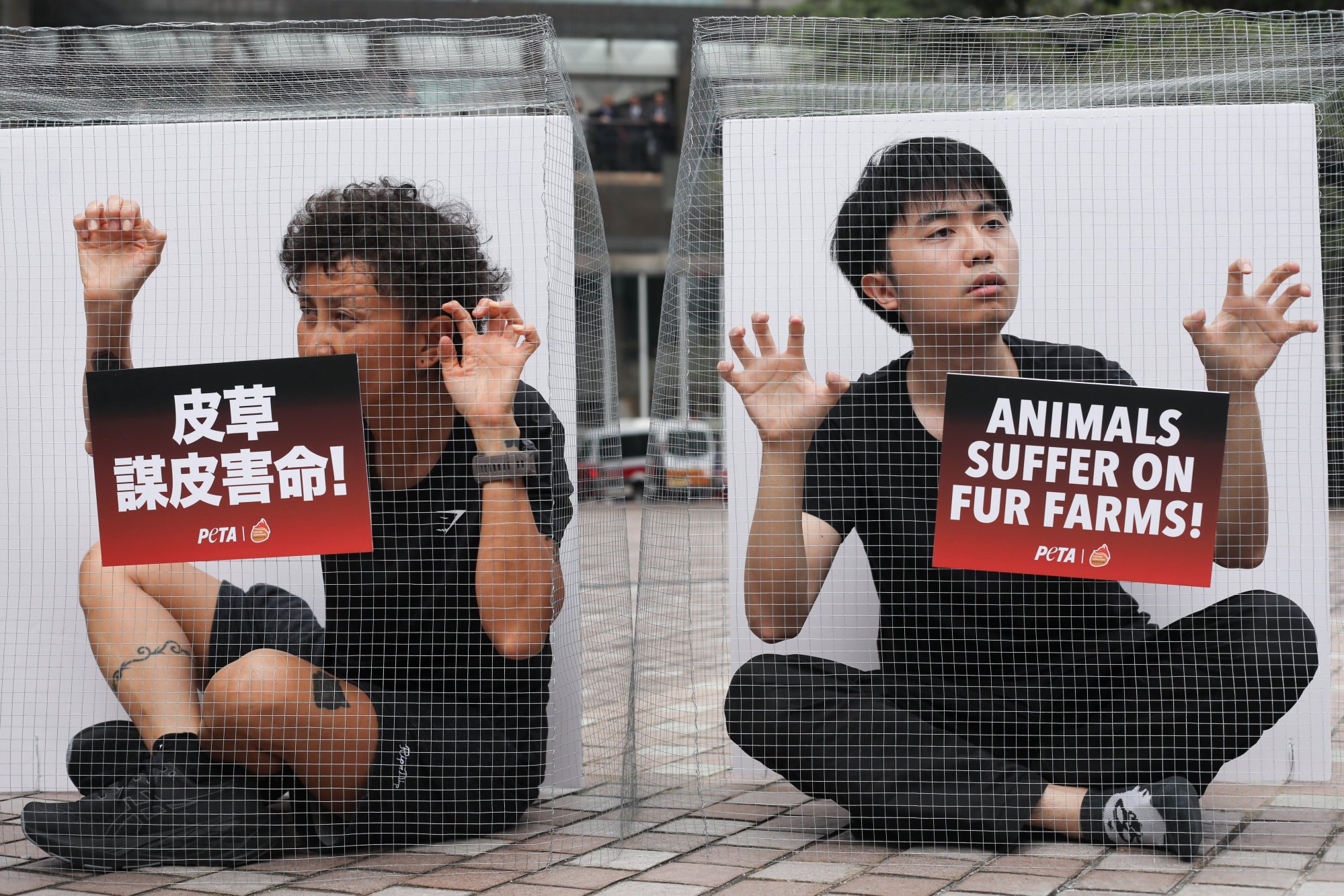
Hong Kong fur show set to open to public for first time ever despite protest by animal rights activists outside venue
- A dozen activists assemble outside Convention and Exhibition Centre on first day of Hong Kong International Fur Fair, with three protesters posing as animals in cages
- Trade show organiser Hong Kong Fur Federation says industry complies with international law, hitting out at ‘slander’ by opposition
Hong Kong furriers are seeking to improve transparency and dispel ethical concerns about the industry by opening an annual trade show to the public for the first time, even as protesting animal rights activists call for an end to the business.
The Hong Kong Fur Federation, organiser of the Hong Kong International Fur and Fashion Fair, said on Thursday the public would be allowed in for the first time since the event’s inauguration in the 1980s, in a bid to educate consumers about the industry’s sustainability efforts.
Honorary chairman Eric Lau Pui-kit said the fur industry had silently suffered attacks by animal activists until the federation changed its mind in recent years.
“If we don’t tell you our side of the story, you will only hear that fur is bad. We want to tell the world that we are also in line with sustainability goals,” he said.
‘More illegal animal traps found in Hong Kong nature areas as dogs get snared’
The fair opened on Thursday at the Hong Kong Convention and Exhibition Centre in Wan Chai and runs until Sunday, with the public allowed in over the weekend.
Lau said the industry practice was to euthanise animals by releasing carbon monoxide into the cage, and they were not skinned alive, as rumoured.
The fair is expected to attract hundreds of international merchants. It will also feature fashion shows, as well as exhibitions and seminars highlighting design trends and sustainability in the fur industry.

The event, the second physical trade show post-pandemic and the biggest, has invited more than 70 buyers from Russia and covered their accommodation costs in the hope of connecting them with emerging markets in countries in the Belt and Road Initiative.
The initiative is Beijing’s plan to link economies in Asia, Europe and Africa into a China-centred trade network.
William Sun King-chian, assistant manager of the Hong Kong Fur Factory, said the industry locally was a “legacy business” which had thrived since the 1950s, and the city remained one of the trade’s biggest hubs.

“Hong Kong is at an advantage in attracting Russian clients, who have faced sanctions from fur hubs in Europe like Italy over the Ukraine war,” Sun said.
“Here, they can enter the city without a visa and connect with businesses on the mainland and South Korea.”
He said the company, which runs a factory in Lai Chi Kok and employs around 40 craftsmen, was one of the last manufacturers of “Made in Hong Kong” fur products.
Hong Kong’s expo business expected to exceed pre-pandemic levels by end of year
Hong Kong is the world’s sixth-largest fur exporter, according to the Trade Development Council, with many local industry operators setting up production lines on the mainland and in Southeast Asia.
The council said the city exported HK$231.6 million (US$28.6 million) worth of fur clothing in 2022, a 42 per cent decrease from HK$398.2 million in 2021. Most of the exports were coats, jackets and shawls made with mink and other fur skins such those from foxes.
In recent years, more high-end fashion brands including Alexander McQueen, Karl Lagerfeld, Gucci and Versace have ditched natural fur and opted for faux versions, following ethical concerns highlighted by animal rights groups.
Earlier on Thursday, activists assembled outside the venue, with some posing as animals in cramped cages, and called for an end to the industry.

One of the protest organisers, Louis Ng Wai-mei, said demand for fur had fallen globally in recent years, showing the public had increased its awareness about animal welfare.
“Many countries around the world have already banned the production and sale of fur skins. Why is Hong Kong still promoting it?” she said at the protest, which was jointly organised by the People for the Ethical Treatment of Animals and Fur Free Hong Kong.
“We are very, very much lagging behind.”
Industry representatives told the Post the International Fur Federation had also been making efforts to ensure industry practices met sustainability and ethical standards, by introducing Furmark, the trade’s first global authority on practices, in 2018.
Hong Kong wild boar incident where man was bitten and creature killed questioned
Furmark CEO Mark Oaten said farms, dressers, dryers and manufacturers which carried the mark followed strict international guidelines, specified in great details such as the size of cages, diets and the amount of activity the animals should get.
Oaten said Furmark had been welcomed by luxury brands such as Louis Vuitton and Dior, which had set respective sustainability standards for the different textiles they used.
“Younger consumers are more conscious about sustainability, they want to know what they are buying and where it comes from. Furmark-certified items carry a QR code, which allows buyers to trace back the origins of the fur skin,” he said.
“It is important we as an industry show we operate to high standards and reassure consumers who want to buy fur.”

